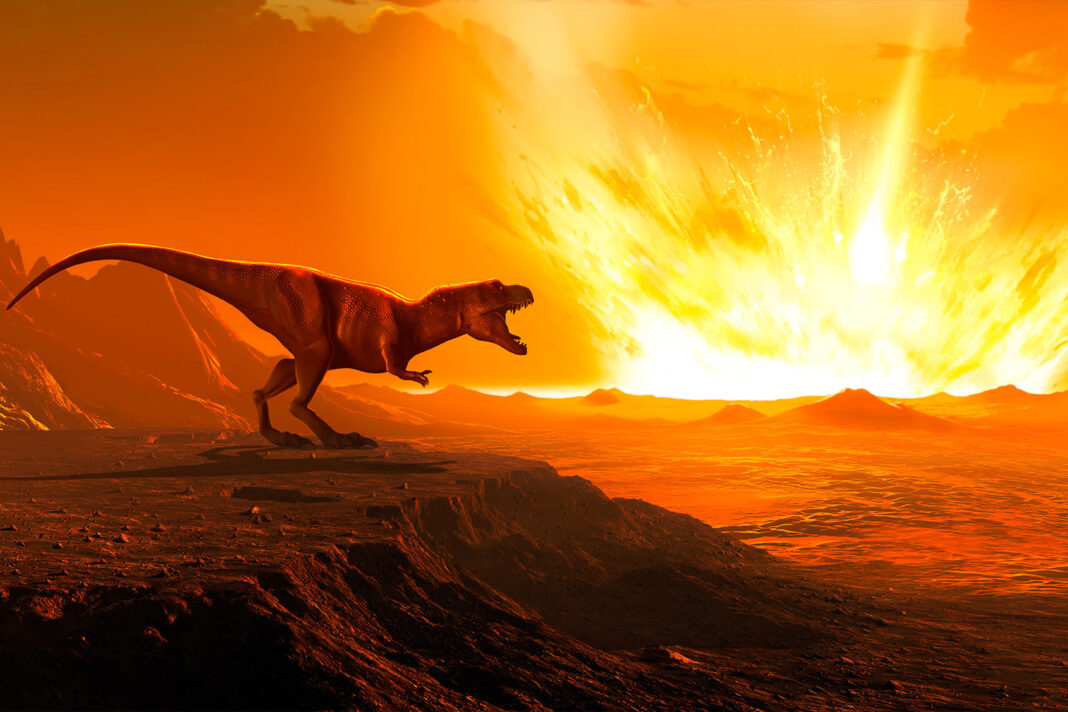— Shares Facebook Twitter Reddit Email view in app Approximately 66 million years ago, an asteroid collided with Earth and caused a mass extinction known as the Cretaceous–Palaeogene (K-Pg) extinction . This event — which, among other things, wiped out the dinosaurs — is one of the most important in geological history. After all, how often do giant asteroids from outer space slam into our planet? As it turns out, perhaps more often than you think.
Indeed, if the theory posited by a new study in the journal Science Advances is correct, it is entirely possible that a second asteroid collided with Earth at roughly the same time as the one that we already know about. That could have huge implications for explaining the history of the evolution of life on Earth. Related The real world behind “Jurassic World”: How the story of dinosaurs reflects the story of humans The known asteroid — that is, the one that caused the extinction of the dinosaurs — landed in what is now the Yucatán Peninsula in Mexico, and left an impact site known as the Chicxulub crater.
The speculative asteroid would have landed in what is now West Africa’s Guinea Plateau and left what is known as the Nadir crater, which is located more than 1,300 feet beneath the sediments of the sea. “At the moment, we cannot definitively state that this is an impact crater – we cannot do that until we recover physical samples of shocked minerals (formed at extreme pressures) from the crater floor by drilling,” Uisdean Nicholson, an assistant professor at Heriot-Watt University, told Salon by email. Yet the evidence, Nicholson said, was persuasive: “the geophysical characteristics are, however, very compelling and hard to explain any other way,” he added.
So are the two meteors related? Were they perhaps part of the same chunk of matter, riven in two some time before striking Earth? Nicholson’s team has a number of hypotheses about how the Nadir crater may be related to the Chicxulub crater. One possibility is that a “flux of asteroids” may have been caused by an earlier collision in the asteroid belt, and these two impacts were merely part of that. Or, the second impact could be unrelated — “part of the background asteroid cratering process that has occurred through Earth history,” Nicholson says.
Moreover, given that Nicholson’s team acknowledges an uncertainty window of “around 1 million years,” the asteroid may not have even collided with Earth at the same time as the one that killed the dinosaurs. “The geophysical characteristics are, however, very compelling and hard to explain any other way. ” “Distinguishing between these hypotheses will require us to obtain high-precision dates from the crater, again only possible through scientific drilling,” Nicholson concluded.
Nicholson was clear that, even if a second smaller asteroid hit Earth at the same time as the famous one, “it would have been dwarfed by the effects of Chicxulub. ” Yet that doesn’t dwarf the potential significance of Nicholson’s find. “The discovery of a terrestrial impact crater is always significant, because they are very rare in the geologic record,” Mark Boslough, a research professor in Earth and Planetary Sciences at the University of New Mexico, told CNN .
(Boslough was not involved in the study. ) “There are fewer than 200 confirmed impact structures on Earth and quite a few likely candidates that haven’t yet been unequivocally confirmed. ” Want more health and science stories in your inbox? Subscribe to Salon’s weekly newsletter The Vulgar Scientist .
Perhaps that is why — regardless of what other scientists learn about the Nadir crater once they are able to drill — Nicholson was able to recall a feeling of joy when he realized what had been discovered. “You realize that, for just a few moments, you are the only person who knows this and understands the implications,” Nicholson told Salon. “But you also want to share it and test the idea.
I was so excited by this discovery that I abandoned most of my other responsibilities and wrote a proposal to go and drill it straight away — submitted a few months later (back in April 2021), but then went back to do the modeling and write the paper while we matured that. ” Nicholson added, “I should also note that this was really serendipity – I wasn’t looking for craters when I came across this. But the more data/information you look at, the more chance that you get lucky.
” Read more about prehistory New paleontology find reveals that tyrannosaurs hunted in packs The delicate evolutionary dance of dinosaurs and ancient plants Were dinosaurs warm- or cold-blooded? A new study settles an old debate By Matthew Rozsa Matthew Rozsa is a staff writer for Salon. He holds an MA in History from Rutgers University-Newark and is ABD in his PhD program in History at Lehigh University. His work has appeared in Mic, Quartz and MSNBC.
MORE FROM Matthew Rozsa Related Topics —————————————— Dinosaurs Evolution Furthering Geology K-pg Boundary Impact Oceanography Science Studies Related Articles Advertisement: Advertisement: Trending Articles from Salon Advertisement: Advertisement:.
From: salon
URL: https://www.salon.com/2022/08/22/second-asteroid-dinosaur-extinction/



